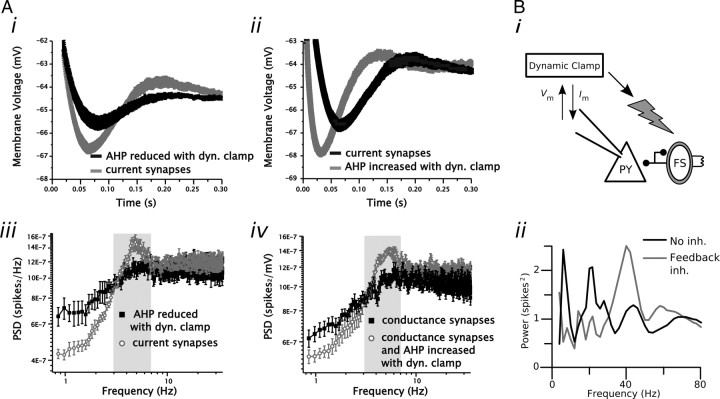Figure 4.
Examples of feedback control implemented with dynamic clamp. A, Manipulation of the spike AHP in medial entorhinal cortical stellate cells using an AHP-reducing (i) or AHP-enhancing (ii) conductance introduced via dynamic clamp can be used to regulate the expression of spike train theta oscillations (iii and iv). Under control conditions, the voltage trajectory immediately following a stellate cell spike AHP is associated with a rebound in membrane voltage (i, ii). By changing the amplitude of the AHP using a spike-dependent feedback conductance, the extent of membrane voltage rebound that follows the spike can be manipulated. Reducing the size of the AHP leads to a reduction in the rebound and a reduction in spike train power at theta (i, iii). Conversely, restoring the size of the AHP restores spike train power at theta (ii, iv). B, Feedback inhibition from inhibitory interneurons is necessary for network-mediated gamma (30–80 Hz) oscillations in neocortical circuits. A photostimulation signal triggered using a dynamic clamp setup monitoring the membrane voltage of a cortical pyramidal cell (PY) can be used to excite a population of interneurons (FS) expressing channelrhodopsin-2. Every time a pyramidal cell elicits a spike a blue light pulse is triggered that leads to excitation of interneurons and subsequent feedback inhibition (inh.) in pyramidal cells. The spike train power spectrum of pyramidal cells shows a peak in the gamma frequency range when the feedback inhibition from inhibitory interneurons is activated using the dynamic clamp-mediated photostimulation (ii). dyn. clamp, Dynamic clamp. A was adapted with permission from Fernandez and White (2008). B was adapted with permission from Sohal et al. (2009).

